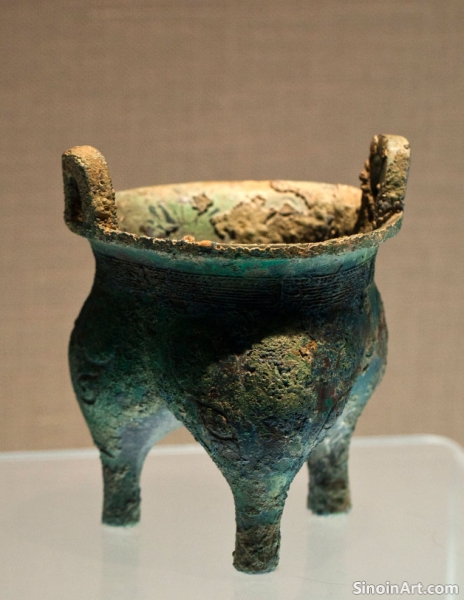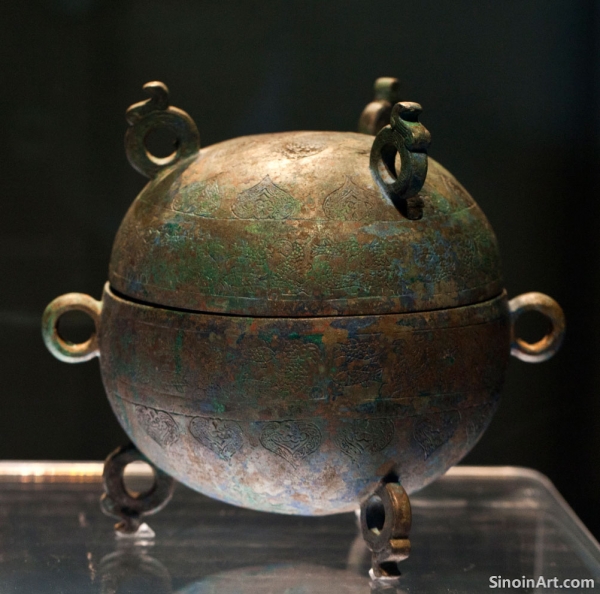Analyzing the Surface Patina of Chinese Bronze Ware: A Story of Time and Environment
|
The surface patina of Chinese bronze ware, that layer of coloration and texture that develops over time, is more than just a sign of age; it is a complex record of the object's history, its interactions with the environment, and the unique characteristics of its creation. Analyzing patina can provide valuable information for both conservation and authentication, as well as enhancing our understanding of the history and art of bronze ware. The patina is a valuable indicator of age and environment.  The specific colors and textures of a patina are influenced by a variety of factors, including the composition of the bronze alloy, the conditions in which the object was buried or stored, and the type of minerals and chemicals present in the surrounding soil. The different patinas that form under varying conditions are a testament to the interplay between the bronze and its environment. The interplay of material, time, and environment is a significant factor in the appearance of the final product.  A naturally formed patina can range in color from green and blue to brown, black, and even red, with each shade and hue telling a different story of the conditions that the object has been exposed to. The study of patina allows us to gain a deeper understanding of the history and environment of bronze artifacts.  However, it is important to distinguish between authentic, naturally formed patinas and those that have been artificially created or enhanced. Conservation experts utilize scientific techniques to differentiate these patinas. Proper understanding of patina helps to aid in the study and identification of pieces of bronze ware. The study of patina, combined with archaeological context and historical records, provides a more complete understanding of the complex stories that these ancient objects have to tell. The patina itself is a valuable source of information and insights. The careful study of patina is an important element in the proper understanding of the bronze ware. |
Tag : bronze patina, Chinese bronze conservation, artifact aging, metal surface analysis, ancient metallurgy
Related information
- Bronze Ware and the Development of Ancient Chinese Writing Styles: A Visual Record of Language Evolution
- Bronze Ware and the Development of Ancient Chinese Legal Codes: Recording Laws and Reinforcing Authority
- Bronze Ware and Ancient Chinese Astronomy: Celestial Symbols and Interpretations
- The Influence of Ancient Chinese Bronze Ware on Later Korean Art and Design
- The Taotie Motif: Unraveling the Mystery of the Shang Bronze Beast
This article explores how inscriptions on bronze ware provide a visual record of the evolution of ancient Chinese writing styles, highlighting the influence of the medium on script forms, layout, and the development of calligraphic principles.
This article explores the use of bronze in the development of ancient Chinese legal codes, highlighting its role in creating tablets, plaques, and vessels that were used to display laws, promote authority, and reinforce social order.
This article explores the connection between bronze ware and ancient Chinese astronomy, highlighting the use of celestial symbols, the representation of astronomical phenomena, and the use of bronze in astronomical instruments, showcasing the interplay between art and science.
This article explores the influence of ancient Chinese bronze ware on later Korean art and design, highlighting the adaptation of Chinese forms and techniques, the development of unique Korean styles, and the role of cultural exchange in shaping artistic traditions.
This article explores the taotie motif found on Shang Dynasty bronzes, discussing its composite features, the various interpretations of its symbolic meaning, its evolution over time, and its significance in understanding the Shang worldview.